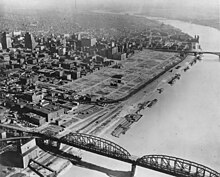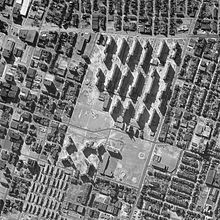History of St. Louis (1905–1980)
Although St. Louis made civic improvements in the 1920s and enacted pollution controls in the 1930s, suburban growth accelerated and the city population fell dramatically from the 1950s to the 1980s.
[1] Among the progressive social reformers on the city parks committee during this time was Charlotte Rumbold, who later was an officer of the Playground Association of America with Jane Addams.
[14] In the early 1910s, however, predominantly white areas of St. Louis that bordered the black community formed the United Welfare Association (UWA), a group dedicated to lobbying for a segregation ordinance.
[16] Although the ordinance was invalidated, private restrictive covenants began appearing in St. Louis real estate transactions that limited the ability of white owners to sell to blacks.
[21] In spite of this show of support for Wilson's policies, non-German St. Louisans began to embrace nativism and distrust the intentions of the Germans, especially after U.S. entry into the war in April 1917.
[22] In addition, citizens began reporting suspicious conversations overhead on streetcars or public streets, submitting names for prosecution under the Espionage Act of 1917.
[24] Extending west from downtown and south of Union Station were the yards for the Missouri Pacific and the Frisco, more meatpacking plants, and the Liggett and Myers tobacco factory.
[31] In late 1932, St. Louis voters passed a $4.6 million bond issue to provide more relief funds, and in the spring of 1933, Mayor Bernard Dickmann and the Board of Aldermen balanced the city budget by reducing expenditures by 11 percent.
[30] Another bond issue for improvements came in 1934, providing funds for city beautification and renovations on civic buildings, reducing the number of persons on direct relief aid to 35,000 in 1936 from more than 100,000 in 1933.
[39] City building inspectors selected 200 sites as air raid shelters, enough to house 40,000 people, and local schools began preparing students for attack.
[39] St. Louis industry had already begun preparing for war starting in 1940, when the government placed a $16 million order with Curtiss-Wright aircraft company for training and cargo planes.
[42] Monsanto converted entirely to war production, producing chemicals used in the making of TNT, chlorine gas, and sulfa compounds that treated infections.
[43] By the end of the war, more than 75 percent of St. Louis manufacturers had engaged in defense work, including the making of various types of ordnance and weapons, uniforms and footwear, K-rations, and chemicals and medical drugs.
[44] In 1944, the St. Louis Chevrolet factory began producing DUKWs and other amphibious vehicles for the invasion of Normandy, while tank and airplane manufacturing continued at a rapid pace.
[46] During a combat flight in the Pacific in February 1942, O'Hare shot down five Japanese bombers that were on a run to attack the USS Lexington, for which he was awarded the Medal of Honor and a parade in St.
[56] The war also was responsible for the first city integration ordinance, which passed the Board of Aldermen in March 1944 and allowed African-Americans to eat at city-owned (but not private ) lunch counters.
[57] No changes in Jim Crow segregation policies at lunch counters resulted; however, Saint Louis University admitted its first black students starting in the fall of 1944.
[62] The surrender of Japan in August 1945 meant the cancellation of $250 million in war contracts in St. Louis, while 80,000 St. Louisans lost their jobs immediately, causing temporary economic problems in the region.
[68] Starting in the early 1910s, St. Louis businessman Luther Ely Smith had pushed for a riverfront rehabilitation project to promote green spaces and better living conditions near the wharf.
[68] The commission approved LaBeaume's land clearance and memorial design plan, and in 1935, the city issued a $7.5 million bond to purchase and demolish buildings at the site.
[72] During the 1950s and 1960s, nearly $20 million more was appropriated by the federal government to complete the project, in addition to money from the Terminal Railroad Association, Bi-State Development Agency, and a 1967 bond issue by the city of St.
[76] The exterior of the new park was designed by Edward Durell Stone to echo the Gateway Arch, and the Cardinals moved into Busch Memorial Stadium for the 1965 season.
[78][79] Despite these two projects and the efforts at civic improvement starting in the 1920s, after World War II more than 33,000 houses in St. Louis had shared or outdoor toilets, while thousands lived in cramped, squalid conditions.
[80] The same year Darst promoted a $1.5 million bond issue that allowed for the completion of the St. Louis Gateway Mall project by clearing blocks of land from 15th to 18th streets.
[79] However, the projects were plagued with problems from the beginning; upon its opening, gangs attacked and harassed residents at Darst, while it became quickly apparent that there was too little recreational space, too few healthcare facilities or shopping centers, and employment opportunities were scarce.
[82] Along with the development of the major housing projects was a 1955 urban renewal bond issue totaling more than $110 million, which included funds to purchase land to build three expressways into downtown St.
[83] The Daniel Boone Expressway (signed as U.S. Route 40 and later as Interstate 64) was an eight-mile stretch from the city's western edge near Clayton to the area currently occupied by Busch Stadium.
[85] Nearly 2,000 families and more than 600 individuals were displaced in the project, which provided land for the Daniel Boone Expressway, new industrial sites, and an extension of Saint Louis University.
[86] Among the earliest of these was an attempt in 1926, fostered by a state constitutional amendment, which allowed a Board of Freeholders to create a plan in which the city would annex all of St. Louis County.
[88] As the population of St. Louis County grew, local subdivisions began multiplying and incorporating into tiny cities and towns, producing more than 90 separate municipalities by the 1960s.



